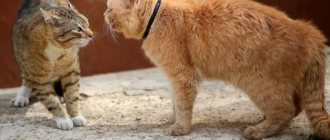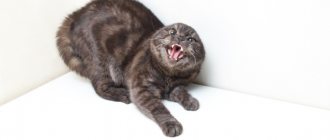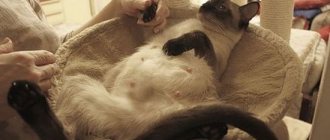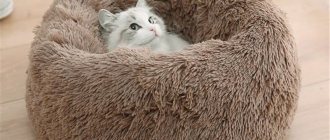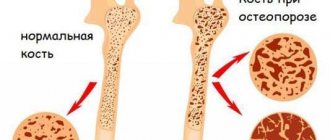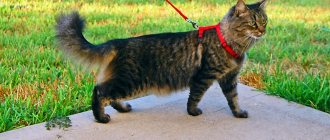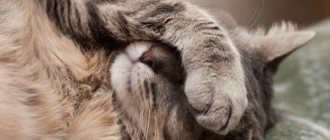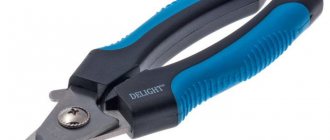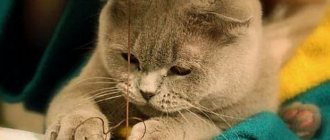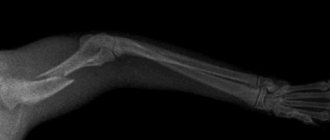Flatulence occurring in cats is a common phenomenon, which is an excessive accumulation of gases in the intestines. Often this condition is accompanied by rumbling in the stomach, hiccups, alternating constipation and diarrhea. A number of factors can provoke the problem, some of which are dangerous. Therefore, if bloating is detected, the animal should be taken to a veterinary clinic.
Causes of the condition
Non-pathological factors
Cats can pass gas not only because of health problems; there are also harmless reasons, for example, an incorrect diet. It is not recommended to give adult animals milk, bread, or fatty foods. In addition, the fish that owners are accustomed to feeding their pets is poorly absorbed by their bodies, so it is given in limited quantities. You should not feed cats sweets, sausages or smoked meats.
Under normal conditions, when eating food, the animal swallows a small amount of air, but it is so minimal that it does not affect digestion. However, sometimes cats take large gulps of air, which is called aerophagia in veterinary medicine. It is observed when a cat eats too large pieces of food, salty foods, or foods that have an excessively high or low temperature. This condition does not require treatment. Owners only need to give their cat small pieces of food at room temperature.
Pathological factors
Flatulence can also be due to the following reasons:
This condition is typical for animals that have parasites.
- Worm infestation. When a pet is infected with worms, rumbling in the stomach, attacks of nausea and vomiting, and diarrhea are observed. Cats pass gas and their tummy is swollen. If the owners do not notice the problem in time, helminthic infection sometimes leads to death, since serious intoxication of the body is observed.
- Peritonitis. It is considered one of the most life-threatening factors for a cat when flatulence occurs. Pathology can be triggered by a number of factors, including coronavirus, which cannot be treated and leads to death.
- Ascites. During this disease, a large amount of fluid accumulates in the abdominal cavity, which causes flatulence. The kitten's stomach growls strongly, while the appetite decreases, and the animal becomes weak.
- Neoplasms. Flatulence is sometimes triggered by the presence of malignant and benign tumors in the peritoneal area. Owners in such a situation may notice that the pet develops diarrhea, exhaustion, and vomiting.
- Constipation. It can be caused by various factors, but is often associated with an improper diet or the presence of worms in the body. At the same time, not only feces, but also gases do not pass through the intestines.
- Plague. The disease is caused by parvovirus. In addition to flatulence, animals experience increased body temperature, diarrhea, vomiting, and loss of appetite. The disease is mainly diagnosed in kittens.
Could cat fart be a sign of serious health problems?
If your cat experiences gas or the gas is caused by something she ate, there is nothing to worry about. The gas will flow on its own.
However, sometimes gas in cats is a symptom of something more serious.
You should call your veterinarian if your cat has persistent symptoms such as vomiting, bloating, bloody stool, foul-smelling gas, or if it refuses to eat or drink.
Some serious gastrointestinal problems in cats include:
- Inflammatory bowel disease
- Ulcers
- Gastrointestinal obstruction
- Worms or other intestinal parasites
- Cancer
Your veterinarian will examine your cat and ask about its diet and health history. They may ask for a stool sample or order blood tests or x-rays to find out what is causing your cat's gas and other symptoms.
How does it manifest?
If an animal is bothered by the accumulation of gases, it may meow pitifully.
Doctors note that the following symptoms are typical for flatulence:
- restless cat behavior;
- plaintive meow;
- vomit;
- constipation or diarrhea;
- rumbling in the stomach;
- muscle spasms;
- bloating;
- loss of appetite;
- thirst.
How can herpes be dangerous?
Herpes can cause many complications. Some of them are life-threatening.
- Bacterial complications. Most often, bacteria simply attach to the virus and the blisters fill with pus. If the blisters have already burst, then the ulcers become covered with pus, the pain in the lip becomes unbearable and a crust does not form.
- Herpetic stomatitis is a lesion of the oral mucosa. The disease begins with a sharp increase in temperature, salivation and sharp pain when chewing food. There are many blisters in the mouth, similar to herpes on the lips.
- Herpetic eye damage begins with pain in the eyes and lacrimation. A person cannot open his eyes due to severe pain. A dangerous condition that can result in blindness.
- Herpes of the esophagus. Occurs when herpes spreads from the lips. There are difficulties when swallowing, severe pain, refusal to eat and weight loss.
- Herpetic pneumonia and herpetic hepatitis occur in people with immunodeficiency and occur together with bacterial and fungal processes.
- Herpetic damage to the nervous system occurs in the form of meningoencephalitis and is the most severe form of herpes. It begins with a sharp headache, nausea and vomiting, high fever, movement disorders and convulsions. The disease is unfavorable.
Photo: To avoid complications, you need to start treating herpes in a timely manner.
Diagnostics
If a cat passes gas for several days, this should alert the owners. In such a situation, you should contact a veterinary clinic. At the appointment, the doctor will conduct a survey of the owners, during which he will find out how long ago the unwanted symptoms arose. Then the veterinarian begins to examine and feel the pet’s abdomen. To confirm the preliminary diagnosis, the cat is sent for the following examinations:
- general and biochemical blood tests;
- stool analysis;
- radiography;
- ultrasonography.
Diagnostic methods
To determine why a cat is not eating and its belly is swollen and hard, your veterinarian must conduct a comprehensive examination of the animal:
- Collection of biomaterial for analysis. Laboratory examination of the blood, urine and feces of a four-legged patient will help to find out whether the animal is infected with parasites. In addition, the specific nature of bowel movements can promptly prompt the doctor that the cat is suffering from tumors of the internal organs.
- Physical examination. Feeling and listening to the cat's abdominal cavity will give the veterinarian an idea of the processes occurring inside, which will make it easier to make a final diagnosis.
- Ultrasound, x-ray. A visual display of the condition of the abdominal cavity will give the physician the most complete picture of the disease.
Only a combination of all the methods described above will allow the veterinarian to determine what exactly the cat is sick with and prescribe appropriate therapy. Despite the similarity of symptoms, not all diseases that cause a hard belly are treated the same.
How is the treatment carried out?
It is necessary to prevent the animal from accessing the trash can.
First of all, veterinarian Tatyana Sergeevna Semirotova recommends normalizing the pet’s diet. Foods that contain large amounts of carbohydrates should be removed from the menu. In addition, it is important for cat owners to prevent the cat from greedily and abundantly absorbing food. The daily intake should be divided into small portions. The temperature of the finished dish should not exceed 25 degrees Celsius. It is important that the animal should not be given spoiled food. If your cat likes to rummage through the trash can, you need to move it out of reach.
When your pet is on complementary food, which is sold in stores, attention should be paid to ensure that it does not contain a lot of fiber, since it provokes flatulence.
The cat may also be prescribed medications. Sorbents are often used, for example, Polysorb and Enterosgel. Therapy for flatulence may also involve the use of probiotics. One of the most effective is a medicine called “Baikal”. In combination with the use of medications, doctors recommend monitoring the animal’s activity. You should take your cat for walks more often, but if this is not possible, active leisure can be organized at home by purchasing a sufficient number of toys for your pet. Physical activity will reduce the risk of gastrointestinal pathologies, including flatulence.
Bacterial infection of the deep layer of skin
Occurs when microbes enter deep into the dermis.
Read also: Breast enlargement pump
Furuncle
First, a painful node appears, then an abscess matures in its center. After 5–7 days it opens, a purulent-necrotic core is released, and the wound is scarred. When there is more than one lesion, they speak of furunculosis.
Carbuncle
These are several boils united into a common infiltrate. The place looks like a purple-bluish tumor. Pain increases, well-being suffers, body temperature rises. After opening the formation, a deep ulcer remains, healing with a scar.
Acne (blackheads)
- inflammation of the sebaceous gland ducts due to blockage. Pustules form on the face, chest, and shoulders. Their contents dry out to crusts, after which, when rejected, scars or bluish spots remain.
Hidradenitis
Purulent inflammation of the sweat glands. The process often recurs. Favorite localizations are armpits, inguinal folds, under the mammary glands. Deep painful nodes appear, bluish-red on the outside. They are opened with the separation of liquid pus.
Prevention
To avoid causing bloating, pet owners need to normalize their diet. You should consult a doctor who will tell you what kind of food leads to flatulence in a particular animal. You need to protect your cat from greedily eating food. It is better to have meals at the same time every day. The menu should limit large amounts of fiber and carbohydrates. In addition, you can train your cat to drink an infusion of medicinal herbs. It is recommended to use chamomile, mint or dill. These remedies reduce the risk of digestive problems.
Main predisposing factors
Aerophagia (“eating” air) is a phenomenon observed during greedy, hasty eating of food. In this case, the animal swallows large volumes of atmospheric air, which accumulates in its digestive system. Diets that contain inappropriately large amounts of soy and other legumes also contribute to bloating. It must be remembered that cats, unlike dogs, are much more sensitive to low-quality products - feeding spoiled food will lead to food poisoning and serious bloating.
Why do cold sores appear on the lips?
Those who suffer from herpes have noticed that exacerbations begin along with ARVI. Herpes occurs when immunity decreases, the protective forces of which are used to suppress ARVI. Colds on the lips also appear when the body’s defenses are weakened: with chronic fatigue, lack of sleep, frequent stress, poor diet, alcohol abuse and active smoking, in women at the beginning of pregnancy and in the first 5-7 days after childbirth.
Photo: Colds on the lips can only appear if the immune system is weakened
Bloating in kittens
When purchasing a kitten, always inspect its tummy. In a healthy animal it should be soft and small. A temporary increase may occur after a recent feeding or shortly before going to the toilet. If a healthy baby's tummy becomes the size of a balloon or a pear, be sure to worm your pet and take him to the vet. Anti-parasite tablets are given at intervals of 2 weeks. At the first ingestion, all adult individuals die, and at the second, the remaining eggs, which have evolved into adult worms, die.
